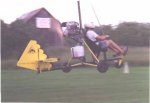wanafly
aging newbe
Hi all... I've been snooping through the forum and quite frankly I'm really impressed... Such a collection of wonderfully talented and inspired oddballs. -Please don't take offense; that's a compliment!
I live at the edge of the woods in southern Washington and am interested in any flying clubs in the area. But more to the point, the wonderful exression of freedom that part 103 seems to offer. So far I've read so much of ya'lls bantering about the hardware that I now dream on Dragon Wings but my dreams are to tool up and have some aluminum ones pulled!
Back to the question: Is part 103 still active? Can I really build and fly (or crash) in a home built plane without asking the FAA for permission? Is the weight 254 lbs with or without the 30 lbs of fuel?
Also, first time to any kind of forum, so please excuse any poor manners but please do advise! :hail:
Thanks,
Keith
I live at the edge of the woods in southern Washington and am interested in any flying clubs in the area. But more to the point, the wonderful exression of freedom that part 103 seems to offer. So far I've read so much of ya'lls bantering about the hardware that I now dream on Dragon Wings but my dreams are to tool up and have some aluminum ones pulled!
Back to the question: Is part 103 still active? Can I really build and fly (or crash) in a home built plane without asking the FAA for permission? Is the weight 254 lbs with or without the 30 lbs of fuel?
Also, first time to any kind of forum, so please excuse any poor manners but please do advise! :hail:
Thanks,
Keith




